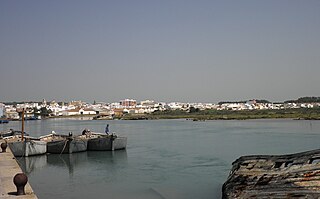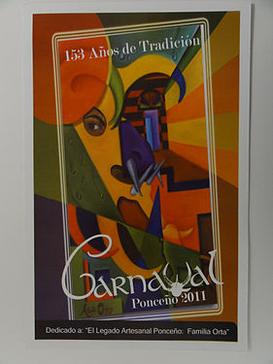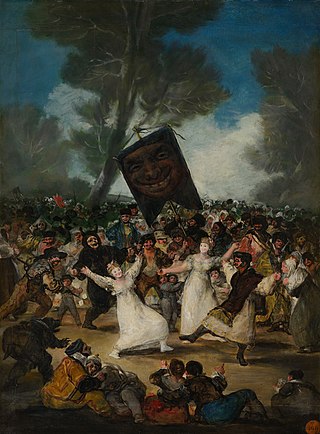
Francisco José de Goya y Lucientes was a Spanish romantic painter and printmaker. He is considered the most important Spanish artist of the late 18th and early 19th centuries. His paintings, drawings, and engravings reflected contemporary historical upheavals and influenced important 19th- and 20th-century painters. Goya is often referred to as the last of the Old Masters and the first of the moderns.

Laredo is a town in the autonomous community of Cantabria, Spain. According to the 2008 census (INE), the municipality has a population of 12,648 inhabitants. In addition to Laredo, the municipality includes the villages of La Arenosa, El Callejo, Las Cárcobas, Las Casillas, La Pesquera, Tarrueza and Villante. Except from the last two, the other villages had been physically integrated into Laredo.

The burning of Judas is an Easter-time ritual that originated in European Christian communities where an effigy of Judas Iscariot is burned. Other related mistreatment of Judas effigies include hanging, flogging, and exploding with fireworks. A similar ritual in Jewish tradition would be the hanging and burning an effigy of Haman and his ten sons during Purim, although this is not a widespread contemporary practice.

Barbate is a Spanish municipality in the Province of Cádiz, in the autonomous community of Andalusia. It is a coastal town located on the shores of the Atlantic Ocean, close to the Strait of Gibraltar. Covering a total area of 142.17 km2, it has, as of 2019, a registered population of 22,518.

Coripe is a city located in the province of Seville, Spain. According to the 2006 census (INE), the city has a population of 1,436.

Villanueva del Fresno is a town in Badajoz Province in Extremadura, Spain.

The Colossus, is known in Spanish as El Coloso and also El Gigante, El Pánico and La Tormenta. It is a painting traditionally attributed to Francisco de Goya that shows a giant in the centre of the canvas walking towards the left hand side of the picture. Mountains obscure his legs up to his thighs and clouds surround his body; the giant appears to be adopting an aggressive posture as he is holding one of his fists up at shoulder height. A dark valley containing a crowd of people and herds of cattle fleeing in all directions occupies the lower third of the painting.

The Carnival of Santa Cruz de Tenerife is held each February–March –depending on the year– in Santa Cruz de Tenerife, the capital of the largest island of the Canary Islands, Spain and attracts people from all over the world.

The Carnaval de Ponce, officially Carnaval Ponceño, is an annual celebration of the Carnival holiday held in Ponce, Puerto Rico. The celebration lasts one week, and like most observations of the holiday ends on Fat Tuesday. Thus, like the Carnival holiday in general, it is usually held in February and or March. It dates back to 1858. Some authorities, such as the Smithsonian Institution, believe the Ponce Carnaval can be traced to as far back as 250 years ago. The Carnaval coincides with the Mardi Gras of New Orleans, the Carnival of Venice, and Rio de Janeiro's Carnival and hundreds of other places that observe this holiday around the world. The estimated attendance is 100,000. Scenes of the 2011 Carnaval Ponceño were featured in the Travel Channel on 7 August 2011.

La Leocadia or The Seductress are names given to a mural by the Spanish artist Francisco Goya, completed sometime between 1819–1823, as one of his series of 14 Black Paintings. It shows a woman commonly identified as Goya's maid, companion and lover, Leocadia Weiss. She is dressed in a dark, almost funeral maja dress, and leans against what is either a mantelpiece or burial mound, as she looks outward at the viewer with a sorrowful expression. Leocadia is one of the final of the Black Paintings, which he painted in his seventies at a time when he was consumed by political, physical and psychological turmoil, after he fled to the country from his position as court painter in Madrid.

The Burial of the Sardine is an oil-on-panel painting by Spanish artist Francisco Goya, usually dated to the 1810s. The title is posthumous, referring to the culminating event, Entierro de la Sardina, of a three-day carnival in Madrid ending on Ash Wednesday. Masked and disguised revellers are seen dancing their way to the banks of the Manzanares, where a ceremonial sardine will be buried. Goya does not illustrate the fish in the painting, nor the large doll made of straw, called a pelele, from which it hung; the centrepiece is the darkly grinning "King of the Carnival".

A Pilgrimage to San Isidro is one of the Black Paintings painted by Francisco de Goya between 1819–23 on the interior walls of the house known as Quinta del Sordo that he purchased in 1819. It probably occupied a wall on the first floor of the house, opposite The Great He-Goat.

The Carnival of La Bañeza, in the province of Leon, is a festival declared of national tourist interest that began to gain importance and fame at the beginning of the 20th century during the repression under Franco, due to the prohibition of concealing one's face or wearing a costume. The main characteristic of La Bañeza's carnival is the absence of a costume competition with prizes and monetary compensation for participating, which may occur in carnivals elsewhere. Most of the city dedicates themselves wholeheartedly to the festival, passing on interest through generations. In many cases, participants prepare a year in advance, searching for accessories, fabrics, masks and acts they will perform, motivated by a "carnival feeling", lived during those days. Given this, the disorganized carnival is becoming increasingly popular, dressing up outside of parade hours, or on days without events, in the workplace, etc. looking to surprise and amaze the citizens and visitors.

Cartonería or papier-mâché sculptures are a traditional handcraft in Mexico. The papier-mâché works are also called "carton piedra" for the rigidness of the final product. These sculptures today are generally made for certain yearly celebrations, especially for the Burning of Judas during Holy Week and various decorative items for Day of the Dead. However, they also include piñatas, mojigangas, masks, dolls and more made for various other occasions. There is also a significant market for collectors as well. Papier-mâché was introduced into Mexico during the colonial period, originally to make items for church. Since then, the craft has developed, especially in central Mexico. In the 20th century, the creation of works by Mexico City artisans Pedro Linares and Carmen Caballo Sevilla were recognized as works of art with patrons such as Diego Rivera. The craft has become less popular with more recent generations, but various government and cultural institutions work to preserve it.
Carnival in Mexico is celebrated by about 225 communities in various ways, with the largest and best known modern celebrations occurring in Mazatlán and the city of Veracruz.

Witches' Flight is an oil-on-canvas painting completed in 1798 by the Spanish painter Francisco Goya. It was part of a series of six paintings related to witchcraft acquired by the Duke and Duchess of Osuna in 1798. It has been described as "the most beautiful and powerful of Goya's Osuna witch paintings."
Carnival is the most important and well-known festivity celebrated in Tarazona de la Mancha, in the Spanish province of Albacete.

The Burial of the Sardine in Murcia since 1851, is a festivity that is celebrated in Murcia (Spain) during the Spring Festival, whose main event is a parade of floats and men dressing in dresses that culminates with the burning of the sardine on the Saturday after Holy Week.The Burial recalls the old pagan myths. The fire has a cleansing function. It was declared a Fiesta of International Tourist Interest by the Ministry of Industry, Tourism and Trade of Spain.

The Plaza de Gabriel Lodares is a square of Albacete (Spain) located in the center of the city.

The Spanish Rococo style of the 18th century is relatively unexplored and bears little resemblance to its French equivalent. Under the reign of Philip V of the Bourbon Dynasty, architectural commissions were primarily awarded to Italian architects, rather than the French who were the pioneers of the rococo style. This is largely due to the influence of his second wife, Elisabeth Farnese of Parma, who aimed to transcend French influence through the promotion of the Italians. Consequently, Rococo was left to be discovered by the Spanish school and therefore evolved separately from French and other variations of Rococo.


















